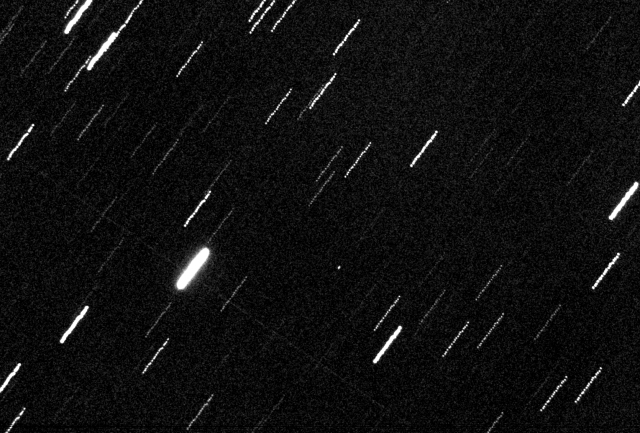Forum Replies Created
-
AuthorPosts
-
5 September 2018 at 11:55 pm in reply to: New RCB star in Cam – call for photometry/spectroscopy #579966
 David SwanParticipant
David SwanParticipant2018 09 05 20:35 UT
Maxim DL Photometry on 10 x 20s stack through Baader V filter
Ref (000-BMT-466) set as V = 13.77
Variable (IRAS 03536+6235) measured V = 15.08
Check (000-BMT-467) measured V = 14.20
5 September 2018 at 12:36 pm in reply to: New RCB star in Cam – call for photometry/spectroscopy #579964 David SwanParticipant
David SwanParticipantStill waiting on a clear patch. Hopefully I’ll get my first measurement this eve.
1 September 2018 at 11:41 pm in reply to: New RCB star in Cam – call for photometry/spectroscopy #579952 David SwanParticipant
David SwanParticipantThanks for pointing this out Gary. I’m going to adopt this star and do regular filtered V measurements with my CMOS. There seems to be a good number of suitable APASS stars within 20-30arcmin for reference and check. David
 David SwanParticipant
David SwanParticipantThanks to all the contributors and the editorial team. A good read!
 David SwanParticipant
David SwanParticipantAbsolutely superb Nick. The sky is very busy now isn’t it! I see this all the time too.
Good plan about the astrometry. I’ve taken another sequence of images – after syncing the computer clock – and I’ll do the measurements tomorrow.
 David SwanParticipant
David SwanParticipant
This NEO will pass less than a third of a degree from Pherkad Major (UMi) at around 4am on 2nd September, when it is expected to be around mag 15. It is brightening rapidly at the moment. Here is an animation of its movement from 2018/08/30 21:16:33 – 21:22:47 UT taken from Tynemouth, UK. What I presume to be a satellite also flashes by too!
[40MB]
 David SwanParticipant
David SwanParticipantThe Orion 8in f/3.9 astrograph (FL 800mm) is less than 500 pounds. I think with a Baader coma corrector it should be a good fit. This combo is on my wish list. The reviews that I have read have been very complimentary.
10 August 2018 at 12:27 pm in reply to: Did Aboriginal Australians Discover the Variability of Betelgeuse? #579856 David SwanParticipant
David SwanParticipantThanks for pointing out this article, Jeremy.
24 July 2018 at 7:51 pm in reply to: Updated, and hopefully final, proposal to the BAA Council #579751 David SwanParticipant
David SwanParticipantThis all sounds very sensible. You can count me as a supporter of this plan. David
 David SwanParticipant
David SwanParticipantTransparency poor, but managed 10 frames when it seemed to clear slightly. 10 x 10s
 David SwanParticipant
David SwanParticipantNot looking as impressive this evening (20 Jul / 2300 BST). Fingers crossed that this isn’t the beginning of the end….
 David SwanParticipant
David SwanParticipantLOL. It all ended amicably and I’m sure well reasoned arguments will – in the long run – lead to downward-directed, low colour-temperature, and proportionate-intensity lighting nationwide.
 David SwanParticipant
David SwanParticipantLast year – I forget precisely when – I had the telescope out on some land jutting into the sea, a great dark spot if winds are light. A curious member of the public came over and we had a good talk and I showed him some bright DSOs. He then proceeded to tell me that he was the person primarily responsible for installing the LEDs all over Tynemouth, and wasn’t it just wonderful ….
16 July 2018 at 5:25 pm in reply to: interesting potential PHA discovered by an amateur team #579713 David SwanParticipant
David SwanParticipantI believe the close approach was June this year (2018), so we’ve missed the best of it. It is low down in Capricornus now, and dimmer than mag 16, but I might have a go if I get a really clear southern sky.
 David SwanParticipant
David SwanParticipantThe coma looks like it has expanded significantly since last night. Still bright and quite something.
 David SwanParticipant
David SwanParticipantThanks very much Dominic – and Andy.
 David SwanParticipant
David SwanParticipantLooking quite spectacular as a big fuzzball moving through the star field.
 David SwanParticipant
David SwanParticipantThanks for pointing this out. I’ll have a look. David
 David SwanParticipant
David SwanParticipantThanks for pointing out this object. I have been wanting to have a look – and get a low res spectrum with my StarAnalyser – but cloud has been rolling in from the sea night after night after night!
 David SwanParticipant
David SwanParticipantFor anyone who is interested, here is a link to a new ATEL where the authors discuss photometry and spectroscopy of this transient. Not definitively a broad-lined type Ic supernova – previously, Robin raised uncertainty about this classification too.
-
AuthorPosts
